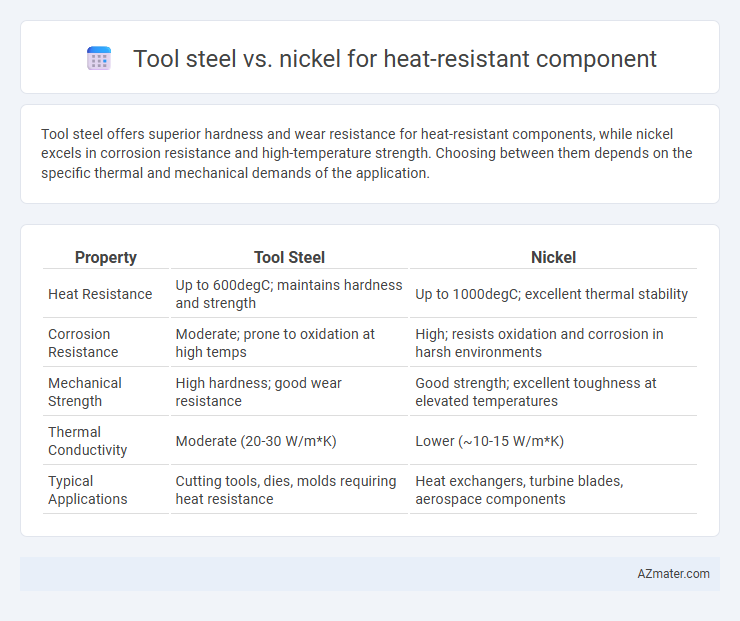Tool steel offers superior hardness and wear resistance for heat-resistant components, while nickel excels in corrosion resistance and high-temperature strength. Choosing between them depends on the specific thermal and mechanical demands of the application.
Table of Comparison
| Property | Tool Steel | Nickel |
|---|---|---|
| Heat Resistance | Up to 600degC; maintains hardness and strength | Up to 1000degC; excellent thermal stability |
| Corrosion Resistance | Moderate; prone to oxidation at high temps | High; resists oxidation and corrosion in harsh environments |
| Mechanical Strength | High hardness; good wear resistance | Good strength; excellent toughness at elevated temperatures |
| Thermal Conductivity | Moderate (20-30 W/m*K) | Lower (~10-15 W/m*K) |
| Typical Applications | Cutting tools, dies, molds requiring heat resistance | Heat exchangers, turbine blades, aerospace components |
Introduction to Heat-Resistant Materials
Tool steel offers exceptional hardness and wear resistance at elevated temperatures, making it ideal for heat-resistant components exposed to mechanical stress. Nickel-based alloys excel in retaining strength and corrosion resistance in extreme heat environments, often surpassing tool steel in thermal stability and oxidation resistance. Selecting between tool steel and nickel depends on operational temperature ranges, mechanical load requirements, and exposure to corrosive atmospheres.
What is Tool Steel?
Tool steel is a type of alloy steel specifically engineered for high hardness, wear resistance, and the ability to retain strength at elevated temperatures, making it ideal for heat-resistant components. It typically contains elements like carbon, chromium, vanadium, and molybdenum, which contribute to its exceptional durability and thermal stability. Unlike nickel alloys, tool steels are optimized for cutting tools and molds, offering superior hardness and heat resistance in demanding industrial applications.
What is Nickel?
Nickel is a corrosion-resistant metal known for its excellent heat resistance and ability to maintain strength at high temperatures, making it ideal for heat-resistant components. Unlike tool steel, which combines hardness and durability for cutting and shaping, nickel alloys offer superior oxidation resistance and thermal stability in extreme environments. These properties make nickel a preferred choice in aerospace, chemical processing, and high-temperature industrial applications.
Heat Resistance: Tool Steel vs Nickel
Tool steel offers moderate heat resistance suitable for applications up to approximately 600degC, but its performance declines significantly at higher temperatures due to oxidation and thermal fatigue. Nickel alloys, such as Inconel and Hastelloy, exhibit superior heat resistance, maintaining strength and corrosion resistance beyond 1000degC, making them ideal for extreme heat environments. The choice between tool steel and nickel depends on operating temperature requirements, with nickel preferred in high-temperature, corrosive settings.
Mechanical Strength and Durability Comparison
Tool steel exhibits superior mechanical strength and hardness compared to nickel, making it more resistant to wear and deformation under high-stress conditions. Nickel alloys, however, offer enhanced corrosion resistance and maintain mechanical integrity at elevated temperatures better than most tool steels. In heat-resistant components, the choice between tool steel and nickel depends on the balance between required tensile strength, hardness, and long-term durability in harsh thermal environments.
Oxidation and Corrosion Resistance
Tool steel offers excellent hardness and wear resistance but typically has limited oxidation and corrosion resistance at high temperatures compared to nickel alloys. Nickel-based alloys exhibit superior oxidation resistance due to the formation of stable oxide layers, making them ideal for heat-resistant components exposed to aggressive environments. Corrosion resistance in nickel alloys is enhanced by their ability to withstand acidic and alkaline conditions, whereas tool steels may require protective coatings to achieve similar durability.
Cost and Availability Considerations
Tool steel generally offers a lower-cost option compared to nickel-based alloys, making it more economically viable for heat-resistant components in budget-sensitive applications. Nickel alloys, while more expensive due to complex refining and alloying processes, provide superior corrosion resistance and stability at higher temperatures, which may justify their cost in critical environments. Availability of tool steel is widespread with established supply chains, whereas nickel alloys can face supply constraints and price volatility due to reliance on geopolitically sensitive mining regions.
Engineering Applications: Tool Steel vs Nickel
Tool steel exhibits exceptional hardness and wear resistance, making it ideal for cutting tools and molds exposed to moderate heat in engineering applications. Nickel alloys outperform tool steel in high-temperature environments due to superior oxidation resistance and thermal stability, crucial for aerospace and power generation components. Selecting between tool steel and nickel depends on operating temperature, mechanical stress, and corrosion resistance requirements specific to the heat-resistant component's function.
Machinability and Fabrication Differences
Tool steel exhibits superior machinability compared to nickel alloys due to its lower toughness and higher carbon content, allowing easier cutting and shaping with standard tools. Nickel alloys, while excellent for high-temperature resistance, often require specialized machining techniques such as grinding or electrical discharge machining due to their toughness and work-hardening characteristics. Fabrication of tool steel typically involves conventional welding and heat treatment processes, whereas nickel components demand specialized welding procedures and post-weld heat treatment to maintain their heat-resistant properties and prevent cracking.
Choosing the Best Material for Heat-Resistant Components
Tool steel offers excellent hardness and wear resistance at elevated temperatures, making it ideal for heat-resistant components subjected to mechanical stress. Nickel alloys provide superior corrosion resistance and maintain strength at higher temperatures, suitable for applications involving extreme thermal cycling. Selecting between them depends on specific operating conditions, such as temperature range, mechanical load, and environmental factors.

Infographic: Tool steel vs Nickel for Heat-resistant component
 azmater.com
azmater.com